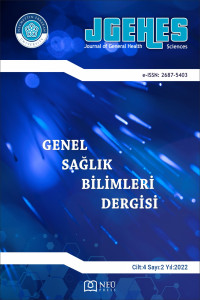Tip 2 Diyabeti Olan Yetişkin Bireylerde Ayak Bakım Davranışının Yordayıcıları: Öz Etkililik ve Yaşam Kalitesi
Abstract
Amaç: Bu çalışmada tip 2 diyabeti olan yetişkin bireylerin ayak öz bakım davranışları, öz- etkililik ve yaşam kalitesi düzeylerini değerlendirmek ve ayak öz bakım davranışına etki eden faktörleri belirlemek amaçlanmıştır.
Yöntem: 18-65 yaş arası tip 2 diyabeti olan 150 kişinin dahil edildiği bu çalışmada tanımlayıcı-ilişkisel araştırma deseni kullanılmıştır. Araştırma verilerinin toplanmasında kişisel bilgi formu, Ayak Öz Bakım Davranışı Değerlendirme Formu, SF-36 Yaşam Kalitesi Ölçeği ve Tip 2 Diyabetlilerde Öz-Etkililik Ölçeği kullanılmıştır.
Bulgular: Bireylerin eğitim durumu, yaş grupları, diyabet süresi, diyabet dışında kronik hastalık, egzersiz yapma durumu ve HbA1C düzeyi, öz-etkililik diyet+ayak kontrolü alt boyutu, tıbbi tedavi alt boyutu, fiziksel egzersiz alt boyutu, öz-etkililik toplam puanı, yaşam kalitesi fiziksel fonksiyon, fiziksel rol, emosyonel rol, enerji/canlılık, ruhsal, sosyal, ağrı ve genel sağlık alt boyutları puanlarının ayak bakım davranışı arasında anlamlı bir ilişki olduğu saptanmıştır (p<0,001). Etkili olan bu belirleyici faktörlerin ayak bakım davranışı üzerindeki değişimin %86,3’ünü açıkladığı saptanmıştır.
Sonuç ve Öneriler: Sonuç olarak araştırmada bireylerin öz-etkililik toplam ve alt boyut puanları, yaşam kalitesi alt boyut puanlarının ayak bakım davranışı üzerinde güçlü bir etkiye sahip olduğu belirlenmiştir.
References
- Abate, T. W., Tareke, M., & Tirfie, M. (2018). Self-care practices and associated factors among diabetes patients attending the outpatient department in Bahir Dar, Northwest Ethiopia. BMC Research Notes, 11(1), 800. https://doi.org/10.1186/s13104-018-3874-8.
- Ahmad Sharoni, S. K., Abdul Rahman, H., Minhat, H. S., Shariff-Ghazali, S., & Azman Ong, M. H. (2018). The effects of self-efficacy enhancing program on foot self-care behaviour of older adults with diabetes: A randomised controlled trial in elderly care facility, Peninsular Malaysia. PloS one, 13(3), e0192417. https://doi.org/10.1371/journal.pone.0192417
- Ahmad Sharoni, S. K., Mohd Razi, M. N., Abdul Rashid, N. F., & Mahmood, Y. E. (2017). Self-efficacy of foot care behaviour of elderly patients with diabetes. Malaysian Family Physician,12(2), 2–8.
Abstract
Purpose: This study aimed to determine foot self-care behavior, self-efficacy, and quality of life levels of adults with type-2 diabetes mellitus and to identify the factors affecting foot self-care behavior.
Methods: A descriptive-correlational research design was used for the study, which included the participation of 150 individuals between the ages of 18 and 65 with type-2 diabetes mellitus. A personal information form, the Foot Self-Care Behavior Assessment Form, SF-36 Quality of Life Survey, and Type 2 Diabetes Self-Efficacy Scale were used for the collection of research data.
Results: The results from the study showed that there was a statistically significant relationship between the foot self-care behavior of the participants and educational status, age group, duration of diabetes, presence of chronic disease other than diabetes, exercise, HbA1C level, their diet+foot control, medical treatment, exercise status, self-efficacy sub-dimensions’ and total scores, and physical functioning, social functioning, role limitations due to physical problems, role limitations due to emotional problems, energy/vitality, mental health, pain, and general health perception sub-dimension scores of the quality of life (p<0.001). These factors were found to account for 86.3% of the variance in foot self-care behavior.
Conclusion and Suggestions: In final, it was determined that the total and subdimension self-efficacy scores and the quality of life sub-dimension scores of the participants had the strongest relationship with foot self-care behavior.
References
- Abate, T. W., Tareke, M., & Tirfie, M. (2018). Self-care practices and associated factors among diabetes patients attending the outpatient department in Bahir Dar, Northwest Ethiopia. BMC Research Notes, 11(1), 800. https://doi.org/10.1186/s13104-018-3874-8.
- Ahmad Sharoni, S. K., Abdul Rahman, H., Minhat, H. S., Shariff-Ghazali, S., & Azman Ong, M. H. (2018). The effects of self-efficacy enhancing program on foot self-care behaviour of older adults with diabetes: A randomised controlled trial in elderly care facility, Peninsular Malaysia. PloS one, 13(3), e0192417. https://doi.org/10.1371/journal.pone.0192417
- Ahmad Sharoni, S. K., Mohd Razi, M. N., Abdul Rashid, N. F., & Mahmood, Y. E. (2017). Self-efficacy of foot care behaviour of elderly patients with diabetes. Malaysian Family Physician,12(2), 2–8.
Details
| Primary Language | English |
|---|---|
| Subjects | Health Care Administration |
| Journal Section | Research Articles |
| Authors | |
| Early Pub Date | August 25, 2022 |
| Publication Date | August 25, 2022 |
| Submission Date | June 17, 2022 |
| Acceptance Date | July 25, 2022 |
| Published in Issue | Year 2022 Volume: 4 Issue: 2 |
Journal of General Health Sciences is licensed under a Creative Commons Attribution-NonCommercial 4.0 International License (CC BY NC).


